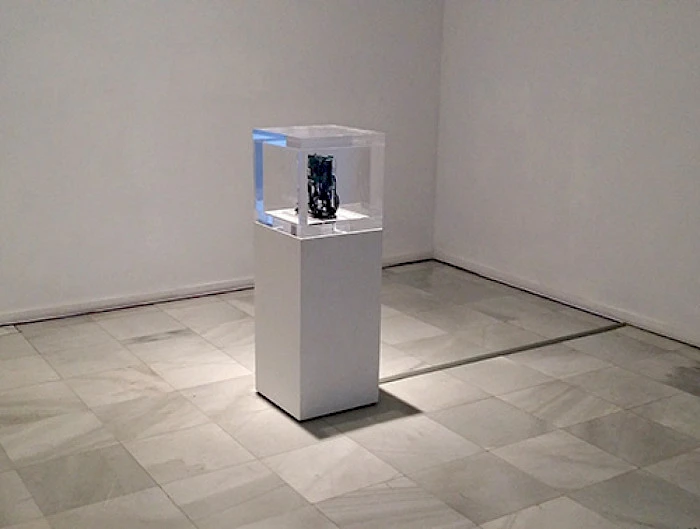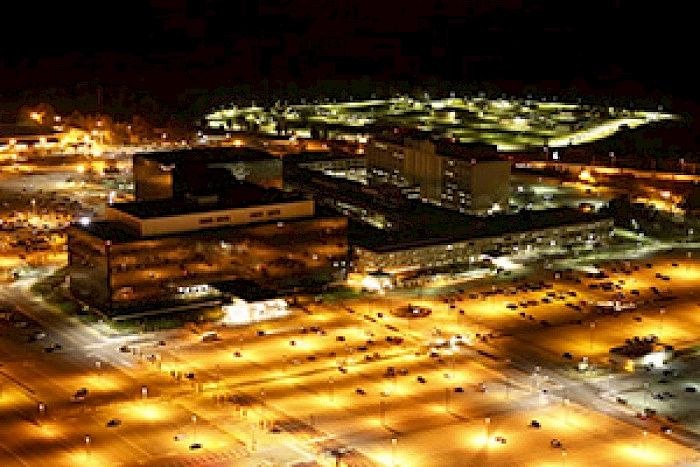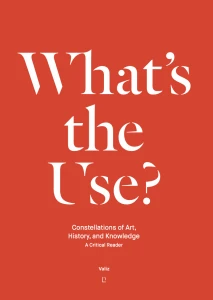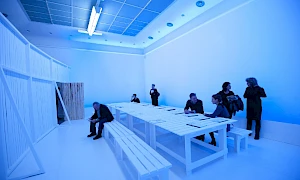
National Geospatial-Intelligence Agency, Springfield, Virginia, 2012. Photo credit: Trevor Paglen.
Nick Aikens (NA): One of the areas we have reflected on in The Uses of Art programme is the relationship between aesthetics, representation, and use. Why I felt it was important to include Autonomy Cube (2014, produced with Jacob Applebaum) within this discussion is that it both embodies and addresses this relationship, as well as implicates the art institution in a really intelligent way. Before discussing the work directly, I'd like to talk about the role of images, representation, and the visible in your work. You often address images from a particular vantage point—namely in relation to the invisible or the unseen.
Trevor Paglen (TP): In my image-based work there are two sides: one plays with representation and the second is the process that gave rise to the image and the politics within that process. I have a lot of sympathy for the avant-garde argument for abstraction. It was saying that as an ethical or political gesture abstraction was images that do not speak themselves. They are powerful precisely because a refusal to speak can also be a form of a political speech. On the other hand it creates a relation between the viewer and the artwork whereby the viewer has to contribute something. In other words, the artwork does not speak itself but asks you to engage with it in a more empowered way. Now this is a good argument to make in 1942 but it's not a good one to make in 2015 because it completely ignores the economy of art objects these days. But the kernel of that argument is that I'm interested in images that don't speak themselves, images that you look at and can't really get much information from.
There is also the work that I do to make the image which in many cases involves things like tracking spy satellites or trying to figure out where different NSA infrastructures are, or infrastructures associated with covert actions. There is a politics in that process: first, ascertaining where those places are, second insisting on my right to take that photograph, and then third introducing—in this kind of elliptical, metaphorical way—these images and their associations into the world. So, a basic example would be that before I started studying spy satellites I never really even thought about the fact that they existed very much. And I think that by putting an image in a museum or magazine and saying 'this is a kind of spy satellite' you put it on the cultural agenda. You ask people to think about the fact that it's there.
NA: But you are still using the language of aesthetics and a certain opacity that allows you to address representation in a specific way. With Autonomy Cube these relationships and references become more pronounced. Could you describe Autonomy Cube physically, the references it draws on and then what it does, its use?
TP: Autonomy Cube is usually a forty-centimetre-thick Plexiglas cube. Inside that cube are several Novena motherboards, which are open hardware, open source computers. That entire cube generally sits on a plinth with a power cable and an Ethernet cable going into it. What the cube does is plug into the host institution's Internet connection and it does a couple of things with that. The first thing is it creates an open Wi-Fi network throughout the museum, an open network called Autonomy Cube that anybody can access. Instead of being a normal kind of Wi-Fi hotspot that you would find in an airport or in a café, it is a special kind of hotspot in that it encrypts and anonymizes all the data that goes over it. So it's the exact opposite of the hotspot you'd find in a café or airport, where the whole point of providing the free Wi-Fi is to spy on you. It makes it impossible for people to spy on you by routing all the traffic over something called the Tor network. The Tor network is a kind of alternative infrastructure for the Internet, although you access the same Internet over Tor that you do through your ISP or whatever. Now normally the way that the Internet works is that if you connect from your house for example, you have an IP address that is specifically assigned to you. Let's say you want to visit Wikipedia and let's pretend the server is in Palo Alto. Normally I would connect from my house here, in Berlin at the moment, through a local service provider. The local ISP would say okay, here is Trevor at this address and he wants to send a request to Wikipedia so we are going to send that over to the Internet exchange in Frankfurt and then it's going to go over to the Internet exchange in London and then it's going to go across the ocean through a transponder cable to the US and connect with the server in Palo Alto. Now that whole process is entirely transparent, anybody can look at exactly who I am and what I want to do. Anybody on that network who is looking at the traffic can see that and it's all in the clear. The Internet was designed for all of these devices to trust each other and be transparent with each other. In part because of the very openness of it, this is why the Internet is an incredible tool of global communication, but also the greatest tool of surveillance that humankind has ever created.

Autonomy Cube, installation shot, 2014. Photo credit: Trevor Paglen.
Tor is a way of using Internet differently. When you download Tor, connect to it, and you want to go from my apartment in Berlin to Wikipedia, the first thing it does is encrypt all the traffic. So it makes all the traffic look quite noisy and it only gives each stop on the network enough information to move that data packet to the next location. But your local ISP can't see what the traffic is, it will only say, 'I have a request to go somewhere else. Instead of taking a kind of direct route to the Wikipedia server for example, it bounces the traffic around to a random network of what are called Tor relays around the world. So that signal might go first to Japan, then it might go to South Africa, and let's say it then would come out in Poland and connect to Wikipedia. Anybody looking at that circle can't see what's going on because it's encrypted traffic. And then at the end at Wikipedia the only thing they can see is that you are an anonymous user from Poland, so it's a way of anonymizing my identity and my location. It's a tool designed for people living in countries where the Internet is censored, for example, China or Iran, to get around state censorship, or for people who are in countries that have very bad human rights records to anonymize their traffic and engage in political activities or discussions that might otherwise land them in prison. The tool was created to circumvent state censorship and state surveillance. And now these Tor nodes, these relays I was talking about, like the hypothetical one in Japan or South Africa, are run by a network of volunteers around the world, about 2000 people who donated bandwidth to be a relay and to allow people to anonymize themselves by routing traffic through their own hardware. Now our Autonomy Cube is also one of these relays: it creates a free open network that anybody in the vicinity of the museum can use to anonymize their Internet traffic but it also allows people from around the world to use the museum's Internet connection to anonymize their traffic, so it helps anonymize people all over the world. If you install the piece, it very literally becomes a part of the institution.

National Security Agency, Ft. Meade, Maryland, 2012.
It transforms the politics that are built into the institution's infrastructure. In this way the piece is thinking about a couple of different things that in my mind descend from a series of conversations that artists began to have with the late minimalism of Robert Morris, for example—thinking about phenomenology and relationality within artwork rather than representationalism. This move away from representation was using phenomenological philosophy. I am thinking about relationality as a more robust way of thinking about that, and that you see through artists like Hans Haacke, with his Systems work (1970–present) and legacy of institutional critique, which tried to look at institutional conditions that give rise to something called art and, in a way, expose it. Autonomy Cube isn't actually exposing anything but it is descended from that tradition in the sense that it is intimately integrated within the nuts and bolts of the institution. But instead of being critical it tries to help the institution become more of a civic space as well as contribute to a more civic version of the Internet. If we understand infrastructure is how politics is imbedded in a kind of social and political script, this is a proposal for an object that has different social and political scripts associated with it that as a result feed into the institution.
NA: It also allows for a different type of knowledge production within the museum.
TP: Historically, intellectual exploration has gone hand in hand with privacy and anonymity. But right after 9/11 the FBI in the US wanted to create a law that would allow them to check people's library records, because it would give them a record of what people were looking at and therefore a record of what people were thinking about. And librarians fought this, rightly so, opposing the idea that we are not free politically or intellectually when we are subject to surveillance and state oversight. So fast forward from 2001 to 2015: imagine you want to explore something, politically, culturally, or sexually. Where will you go? The main tool that we all use is the Internet and the Internet is one of the most surveyed things in the world. In many respects it has a dual use. The way it is constructed now is as an instrument of knowledge but at the same time it's also an instrument of mass surveillance. So, an infrastructure like Tor and a piece like Autonomy Cube are attempts to try to keep the part of being able to explore, intellectually and politically, and at the same time try to circumvent the ways in which mass surveillance of the Internet is conducted.
NA: I think it is crucial that it reinvests the notion of autonomy with political meaning.
TP: There's of course a double understanding of autonomy, particularly within the art context. The first is very much pointing to a history of the autonomous art object. There's something really liberating about the idea of an autonomous art object, of engaging in practices and making things that do not have to conform to the rules of the economy, society, or culture. It's an idea of undertaking practices that embody and propose forms of freedom that are not otherwise available. It's a beautiful idea, but it doesn't work. Or rather, it's a theoretical argument that's hard to actualize. The world doesn't work that way. So autonomy is a reference to a history of wanting to make autonomous objects as a gesture that points to a certain kind of freedom.
Within autonomy there is the idea of self-determination. Self-determination is something that's very difficult to engage with in an environment of mass surveillance and political repression, like the conditions we live in today. In a small way a tool like Tor—and this is why Tor was invented—is a way to try and give marginalized people or oppressed people a means to circumvent structures of oppression, with the goal of promoting self-determination and autonomy.
NA: One of the essays in What's the Use?, by Jesús Carrillo, talks about how the institution addresses subjects through a sense of lack. And artists and museums locate this lack by focusing the endless contradictions and problems of the world through a critique of the institution. If we expose the institution it somehow allows us to understand the dynamics of private interest and public good for example. But essentially, we are left with this sense of lack. What I like about Autonomy Cube is that it moves from a focus on the institution that is not only critical or even propositional, to something that functions as an alternative in real time.
TP: That is absolutely crucial. I think for me—and especially in the way I was educated—critique was the be all and end all. I think that's ridiculous. Critique can be easy and it doesn't necessarily get you anywhere. So I'm definitely thinking about projects that instead of critiquing the existing infrastructures and institutions, try to make them better. Instead of 'institutional critique' we can think about 'institutional enhancement.'


